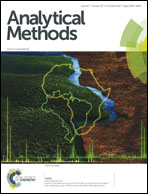Classification of extra virgin olive oil and verification of adulteration using digital images and discriminant analysis
Abstract
This work proposes a new methodology based on digital images and supervised pattern recognition methods for the classification of extra virgin olive oil (EVOO) samples with respect to brand (A, B and C) and verification of adulteration with soybean oil. For this purpose, information in the RGB color space was employed to develop classification models based on linear discriminant analysis (LDA) with previous selection of variables by the successive projections algorithm (SPA), and partial least squares-discriminant analysis (PLS-DA). The performance of classification models was evaluated according to the correct classification rate (CCR) for the prediction set. For the study involving the classification with respect to brand, a correct classification rate of 100% was achieved for both models (LDA and PLS-DA) when applied to the prediction set. The study involving the detection of adulteration with soybean oil in EVOO samples was carried out separately for each brand. For the A EVOO samples, a CCR of 88% and 94% was obtained by SPA-LDA and PLS-DA models for the prediction set, respectively. For the B and C EVOO samples, however, all prediction samples were correctly classified by both models. These results demonstrate the ability of the proposed method and present a promising alternative for the classification of extra virgin olive oil (EVOO) samples with respect to brand and verification of adulteration simply and quickly. Additionally, the method does not use reagents to carry out the analysis and laborious procedures for chemical characterization of the samples are not required.


 Please wait while we load your content...
Please wait while we load your content...